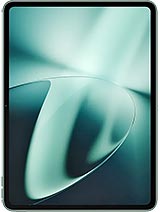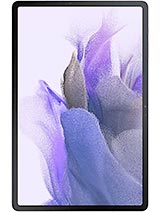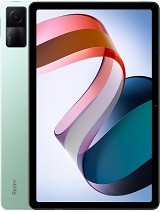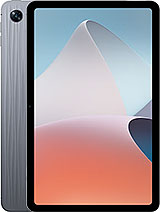OnePlus Pad Go hands-on review

Software and features
The OnePlus Pad Go comes with OxygenOS 13.2 on top of Android 13. This is the latest version of OxygenOS currently only available on one other device, which is the OnePlus Open. It will also be the last as the company formally transitions to OxygenOS 14.

As with the OnePlus Open, it's fair to complain about the lack of Android 14 at launch considering when the device was released. It's an old tactic that allows manufacturers to get out of updating the device with one less Android version in the future by launching with an outdated version. It's a little more egregious on the OnePlus Open considering the cost of that device but it's disappointing on the OnePlus Pad Go nevertheless.
Moving on, the version of OxygenOS we do get on is still very functional with one of the best multitasking abilities around. You get full support for split-screen apps that let you run two apps side by side or one above the other, with adjustable window sizes. You can also run a third app in a floating window and content can be dragged around between all of these.
Oddly enough, the multitasking on the OnePlus Pad Go and even the more expensive OnePlus Pad are inferior to that on the OnePlus Open. The Open can run three apps side by side and a fourth one in a floating window while the two tablets can only do two side by side. That's a shame as the larger screen real estate would have made three apps even more enjoyable to use than on the Open. It's also possible to run some apps in two instances side by side.
Aside from that, you also get a taskbar, which can be permanently docked at the bottom of the screen or hidden. You can place apps here and recently used content can optionally be made to appear. The app library button lets you quickly open any app or drag it out to start multitasking.
Flexible window mode opens the aforementioned floating windows. These windows can be moved around, resized, hidden, and essentially used like a smaller, smartphone version of the app.
Finally, the smart sidebar is a feature carried over from the OnePlus smartphones and lets you keep another dock on the side of the screen for frequently used apps and features.
There are some limitations to the multitasking functionality. As usual, it comes to the apps and how well they can adapt to split screen. Some apps simply do not support this feature and can only be opened in full screen. Some apps also do not support opening in floating windows. Most apps do not support dual windows, including browsers, so you cannot have two instances of them open. You will need to get around this by having, for example, two different browsers side by side.
Some apps like Instagram are also particularly problematic. Instagram famously does not support landscape mode on any device and while OnePlus just let you open the app in a portrait window in landscape in OxygenOS 13.1 on the OnePlus Pad, in OxygenOS 13.2 on the OnePlus Pad Go the app is just forcibly opened in portrait mode only. Not only can you not use it in landscape but you also cannot rotate the device and view the app in portrait in the other orientation. Also, as you can imagine, no floating or split window support.

None of this is OnePlus's fault and Android apps have just proven themselves to be inept at adapting to the tablet form factor. Very few Android apps have a UI optimized for tablet use, with most apps just behaving like they are still running on phones. This one is squarely on the developer community collectively and there is very little OnePlus can do about it.
Aside from that, OxygenOS 13.2 is generally well-designed and all the built-in apps adapt well to the tablet form factor. It's also fairly customizable, with the option to change the usual wallpapers and icons but also fonts and themes. The only limitation is that you cannot change the grid size of icons on the homescreen, which puts limitations on how you can arrange icons and widgets.
The OnePlus Pad Go has LTE connectivity with its built-in SIM slot. This is, essentially, a very large smartphone as you can make and receive calls as well as SMS, aside from just using data while being out and about. Of course, since there is no earpiece, you will have to use a headset or speakers for the calls.
The importance of mobile data cannot be understated as you are no longer limited to places with Wi-Fi to use the device. You also no longer have to bother with enabling a hotspot on your phone and waste its battery power. It's hard to imagine this feature made its way to the cheaper model but isn't available on the much more expensive OnePlus Pad.
The LTE functionality is optional if you buy the 128GB model and you can choose to get just the Wi-Fi model instead. However, the 256GB model only comes in an LTE variant.
Unfortunately, the OnePlus Pad Go does share one thing with the OnePlus Pad, and that is the fact that neither device has a fingerprint scanner. This limits you to using a passcode as the most secure method of locking down the device, which is just inconvenient. It's especially inconvenient if you have apps like password managers, banking apps, and anything else that requires biometric authentication as you will have to either run them in an unsecured way or enter your password manually every time.
Performance
The OnePlus Pad Go runs on the MediaTek Helio G99 chipset. This is the biggest downgrade overall compared to the OnePlus Pad, which runs on the MediaTek Dimensity 9000. The Pad Go pairs that chipset with 8GB LPDDR4X memory and either 128GB or 256GB storage. As mentioned earlier, you can increase the storage using microSD cards.
The performance of the OnePlus Pad Go can best be described as adequate. OnePlus is clearly asking a lot from the humble G99 here, a chipset designed for budget smartphones, by placing it in a device with a high-resolution display and expansive multitasking capabilities. But despite the intensity of the work assigned to it, the G99 rarely ever feels out of breath or even out of place.
The goal of the OnePlus Pad Go clearly seems to be a media consumption device and the G99 is quite adequate for that. Activities like browsing the web, watching movies and TV shows, reading books, listening to music, and scrolling idly through Instagram are all handled with relative ease. The scrolling isn't always silky smooth or stutter-free but is completely fine for the most part. Even when running two apps side by side, the performance is often perfectly fine.
The main limitation here would be the memory. At 8GB, the OnePlus Pad Go doesn't ship with a lot of RAM and while there is the option of enabling RAM expansion and increasing it by another 8GB by utilizing a page file on the storage, this doesn't work nearly as well as the storage is a lot slower than even LPDDR4X memory. So if you are in a browser with a lot of open tabs then it would be relatively easy to run out of memory, which will noticeably affect performance.
Unfortunately, the biggest limitation of the G99 is the GPU performance and the Mali-G57 MC2 absolutely folds when doing anything 3D on the Pad Go's high-resolution display. This is not a device to play 3D games on and you are much better off playing on a similarly priced smartphone.
2D games are less of an issue and if it's just a round of Good Pizza, Great Pizza or Geometry Dash that you are interested in then you can get by quite easily here. However, a lot of Android games don't look great at this aspect ratio because they are built to expect a wide-screen smartphone display. Most just end up cropping out the sides, which reduces your field of view and can make things harder to see.
Reader comments
- Anonymous
- 04 May 2025
- gXJ
You could also get an M1 iPad Air.
- Sanjay
- 29 Sep 2024
- rK8
Can we use sim or esim in this tablet
- Anonymous
- 14 Jul 2024
- Cb8
Yes



















